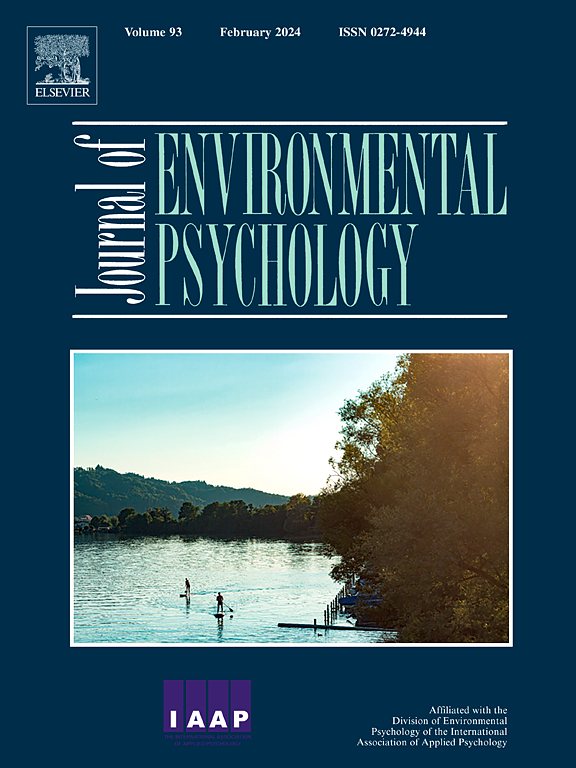着迷调节了自然视频曝光对创造性思维的影响
IF 7
1区 心理学
Q1 ENVIRONMENTAL STUDIES
引用次数: 0
摘要
人们一直认为,接触大自然可以促进创造力,但支持这种关系的因果证据有限。目前的在线实验(n = 297)检验了与城市视频相比,观看自然视频是否能增强语言或视觉形式的创造性发散思维,以及注意恢复理论(远离、着迷、范围、连贯性)或压力减轻理论(积极情绪、放松)假设的恢复性成分是否能调解或缓和暴露对语言或视觉发散思维的影响。对回答的创造性、原创性、灵活性和流畅性进行了测量。自然视频增强了言语发散思维的创造性和原创性,增强了视觉发散思维的创造性。未检测到中介效应。然而,在恢复性成分中,最明显的发现是,着迷能缓和视频暴露对语言和视觉发散思维原创性的影响,这表明被自然吸引或启发的参与者从自然暴露中获益最多。研究结果支持了接触自然对创造性发散思维的积极影响。此外,自然主观体验的个体差异似乎在自然对创造性思维的有益影响中起着重要作用。结果鼓励将自然元素融入建筑环境中,例如工作场所和学校,这些地方的创造力很重要。本文章由计算机程序翻译,如有差异,请以英文原文为准。
Fascination moderates the effects of nature video exposure on creative thinking
Exposure to nature has been thought to facilitate creativity, but there exists only limited causal evidence to support such relationship. The present online experiment (n = 297) examined whether exposure to nature videos, as opposed to urban videos, enhances creative divergent thinking in verbal or visual modalities and whether the restorative components assumed by Attention Restoration Theory (being away, fascination, scope, coherence) or by Stress Reduction Theory (positive emotions, relaxation) mediate or moderate the effects of the exposure on verbal or visual divergent thinking. The responses' creative quality, originality, flexibility, and fluency were measured. Nature video enhanced the creativity and originality of verbal divergent thinking and the creativity of visual divergent thinking. No mediation effects were detected. However, of the restorative components, fascination was most clearly found to moderate the effects of video exposure on the originality of verbal and visual divergent thinking, suggesting that participants who were fascinated or inspired by nature benefited the most from nature exposure. The results support the positive impact of nature exposure on creative divergent thinking. Additionally, individual differences in the subjective experiences of nature appear to play a significant role in the beneficial effects of nature on creative thinking. The results encourage incorporating natural elements into built environments, such as workplaces and schools, where creativity is important.
求助全文
通过发布文献求助,成功后即可免费获取论文全文。
去求助
来源期刊

Journal of Environmental Psychology
Multiple-
CiteScore
10.60
自引率
8.70%
发文量
140
审稿时长
62 days
期刊介绍:
The Journal of Environmental Psychology is the premier journal in the field, serving individuals in a wide range of disciplines who have an interest in the scientific study of the transactions and interrelationships between people and their surroundings (including built, social, natural and virtual environments, the use and abuse of nature and natural resources, and sustainability-related behavior). The journal publishes internationally contributed empirical studies and reviews of research on these topics that advance new insights. As an important forum for the field, the journal publishes some of the most influential papers in the discipline that reflect the scientific development of environmental psychology. Contributions on theoretical, methodological, and practical aspects of all human-environment interactions are welcome, along with innovative or interdisciplinary approaches that have a psychological emphasis. Research areas include: •Psychological and behavioral aspects of people and nature •Cognitive mapping, spatial cognition and wayfinding •Ecological consequences of human actions •Theories of place, place attachment, and place identity •Environmental risks and hazards: perception, behavior, and management •Perception and evaluation of buildings and natural landscapes •Effects of physical and natural settings on human cognition and health •Theories of proenvironmental behavior, norms, attitudes, and personality •Psychology of sustainability and climate change •Psychological aspects of resource management and crises •Social use of space: crowding, privacy, territoriality, personal space •Design of, and experiences related to, the physical aspects of workplaces, schools, residences, public buildings and public space
 求助内容:
求助内容: 应助结果提醒方式:
应助结果提醒方式:


